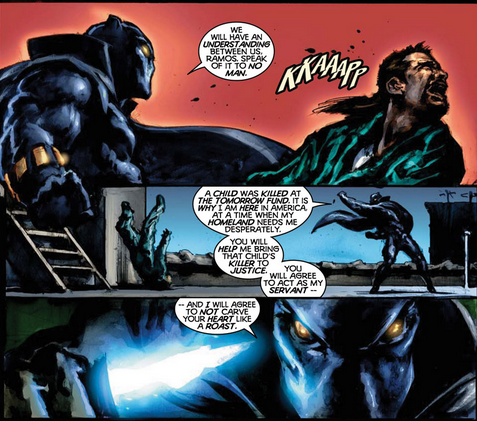Welcome to the first edition of Journey Through Comics: Priest’s Black Panther Part 1.
Today I will ease you in, going over just the first issue of Priest’s run on Black Panther, the start of a story arc known as “The Client.” I will do my best to analyze the text in a vacuum, going over only what is on the printed page, though at times, I will explain things that may not be clear without a wider view of the comic book world at large.

“The Client” opens in a strange enough spot, with a man sitting on a toilet tank in a grungy restroom, with his gun drawn and pointed at something on the floor, just outside the view of the panel. Off-panel, we get some dialogue regarding the history of Wakanda, the fiction nation to which Black Panther rules, but the most important piece of the opening page is the caption box.
Everett K. Ross, self-described “Emperor of Useless White Boys,” is the viewpoint character through not only the opening arc, but throughout the series. We get the narrative of the Black Panther through his lens, and – if the fact this man is in his underwear isn’t hint enough – his lens is panicked. One thing Priest does effectively here is his play with chronological order – as Ross tells relays the events to his boss, Nikki, he skips around a bit – and it works to great order to heighten the tension without undercutting the hero of the story. Many superhero books create potent first stories by having the hero face an insurmountable threat, often getting beat down early before, later in the arc, rising to face the threat.
Priest, however, avoids this, using Ross’ own insecurities to foil the supreme “cool” of the Panther, who we get a glimpse of on page 3, but finally see revealed on a two-page spread.

The imagery here is specifically Western. “The Client” is dressed head-to-toe to impress and his bodyguards, Nakia and Okoye, (collectively titled Dora Milaje, which means “Adored Ones”) are dressed with straightened hair and mini cocktail dresses. The car and the shades at night add to their collective mystique without being overtly flashy.
As the next two pages reveal, “The Client” and his personal escorts are here to interrogate a local hood. Artist Mark Texeira renders this process with vicious efficiency, and Priest uses Ross’ narration to emphasize the ease with which they handle their target.
This imagery serves the story well, as it informs the reader that Black Panther is a hero to be feared and respected. This is a man who is willing to kill for what he wants. Prior to this series, the Black Panther had oft been portrayed as an ineffective hero, many times simply performing the task of the token black member of the Avengers. This was in stark contrast to the way he first appeared in Fantastic Four #52, by Stan Lee and Jack Kirby, who wrote him as a highly effective king and hero, who singlehandedly took out the titular team of superheroes in his debut. This was in July of 1966, months before Huey Newton and Bobby Seale founded the Black Panther Party for Self-Defense in October of that year (though, for history’s note, The Black Panther Party’s logo was adopted by Newton and Seale from the earlier Lowndes County Freedom Organization which predated the character).
From this interrogation, we cut back to Ross getting chewed out by his superior for continuing to jump around. And so, Ross finally starts at the beginning. We cut to Ross’ apartment where he and his boss (who, judging by their dress, are implied to be sleeping together) discuss Ross’ new assignment. Ross is overly confident, and Priest has Ross voice the concerns of the readers about the character, “Nikki — the guy’s as dangerous as Batroc. I mean, think about it — he’s got no powers or anything. I got this. No sweat.”

The injection of history into Ross’ narration is intrinsic to the series, and to the titular character. T’Challa is not just a superhero, he’s a king. While Captain America may use the symbolism of the United States flag in his costume design and act as a representation of the nation’s ideals, Black Panther is his country’s leader. Every action he takes, he takes as the head of both church and state, which means that the weight of his nation is always on his shoulders. Every movement must be calculated as one false step could be taken, not as the actions of an individual, but as an action of a nation. If Black Panther takes a gangster out, a staple of any good superhero, it could be considered an act of war.
This juggling act between being hero and being king is a recurring theme throughout Priest’s run, though it’s only hinted at here in the first issue, from the brief glimpses at Wakanda’s current turmoil to the way T’Challa is escorted by two “wives-in-training.” And soon, everything is going to go straight to hell.
Next week, we’ll take a look at the rest of “The Client” arc. For those looking to read along, the trade paperback of this first arc can be found used on Amazon or on Marvel’s Unlimited Service.


Nice first part. I love the way you stated what was on the page in a matter-of-fact tone. I look forward to your follow up.
Very good summarization of the first part of The Client as well as how Priest got the character. Priest approached T’Challa in t he correct manner.